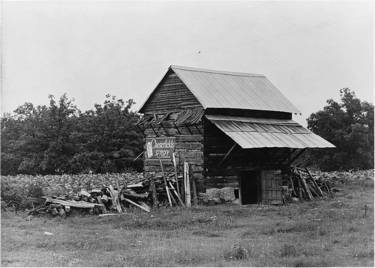Tobacco has been romanticized. Tobacco has been vilified. However, tobacco has been at the center of Caswell County life from the beginning.
Maybe you never saw a plant bed wet with the morning dew, never stepped onto a tobacco field scorching in the midday sun, and never smelled inside a tobacco barn hot and moist with curing tobacco. Maybe you never handed leaves or strung them on a stick, never hoisted tobacco into the dark upper reaches of a tobacco barn (where black snakes often lurked), never tied cured tobacco in the pack barn, and never drove with "sleep" in your eyes to the tobacco warehouse before sunrise. However, if you lived in Caswell County your life was affected by farmers and their families who did these things. From the aromatic days of curing leaves with burning wood, to the change to flue curing and oil as a fuel, to the transition to bulk barns, allotments, quotas, and the government buyout, Caswell County has lived and died by the green tobacco leaf.
For a Caswell County farmer, to be referred to as a "good tobacco man" was the highest praise. Many, if not most, Caswell County farmers grew other crops on their acreage. And, many had good crops of corn, wheat, and oats. And, all were useful. However, it was always tobacco that was referred to as the "cash crop." It was tobacco that determined whether the children would have new clothes for the school year and whether Christmas gifts would be generous. The "good tobacco man" knew all the secrets. He had learned them from his father. From when to put the plant bed "in", to when to "pull" each batch of leaves, to when the tobacco was "cured", to when was the right time to go "to market," the "good tobacco man" had the knowledge. From seeds to market was a long struggle, but he knew how to do it. In correspondence and newspaper articles the word "tobacco" regularly was spelled with the first letter capitalized -- Tobacco -- showing the respect felt for the plant and what it represented.
In 1926 The Caswell Messenger made the following lyrical observations on Caswell County's bright leaf tobacco:
[W]heat and oats find in the soil of Caswell an excellent place for maturity . . but tobacco [is] the county's pride. Everywhere in the county the superlative golden leaf has a history of beauty [and Caswell was indeed] the native home of the golden weed. The story of the Caswell County cutter is known everywhere in the bright belt while tobacco men for years, seeking the last word in the leaf, have looked with admiring eyes upon the Caswell County lingerie wrapper which had caught into its being all the radiant gleams of the Caswell sunrise and the golden glow of the Caswell sunset.
Tobacco production is not unique to North Carolina, nor is it unique to the South. Tobacco is grown as far north as Connecticut and in many other parts of the United States and the world. However, the system of tobacco production based upon slave labor was unique to the South, and North Carolina developed that system to perfection. When slave labor was lost after the Civil War, share-cropping became popular. As recently as 1935 half the farmers in Caswell County were tenants. For many black families, there was no other choice. But, Caswell County was a bit different in this regard. It had few large plantations. It was more a county of farmers than planters. This may have been one reason that it continued to depend upon tobacco after the plantation system fell apart elsewhere in the South. With a good-size family and share-cropper help, most farmers could continue growing tobacco.
Caswell County was different in another regard. In North Carolina, which often is called the "Tobacco State," Caswell County was the home of Bright Leaf Tobacco. It was in Caswell County that Abisha Slade's slave Stephen in 1839 unwittingly cured the first barn of Bright Leaf tobacco upon which the fortunes of the Dukes and the Reynolds were made.
However, even as late as 1860, it was cotton and not tobacco that was North Carolina's leading money crop. But, the northern tier of counties along the Virginia border was outside the cotton-growing belt, and tobacco continued to reign.
It is not possible here to tell the entire history of tobacco or even to cover in detail its development in Caswell County. We must rely upon the references and links set forth below to do that. This history tells us that many Caswell County farmers and planters became very wealthy before the Civil War growing tobacco using slave labor. It shows that their refusal to diversify into other crops and ignorance of soil conservation methods almost bankrupt the once fertile farms of the county, resulting in widespread soil erosion. It shows a stubborn reliance upon tobacco in modern times even when social and political forces became aligned against the tobacco farmer. Even in 2005 the following crops were grown in Caswell County: 4,146 acres of flue-cured tobacco; 2,200 acres of wheat; 1,250 acres of corn; 220 acres of oats; 164 acres of grain sorghum; and 20 acres of barley. Thus, tobacco acreage is greater than all the other field crops combined.
Of note are the pilaster capitals of the 1861 Caswell County Courthouse, which consist of colorfully painted metal ears of corn and tobacco leaves. Nor was the importance of tobacco to the county forgotten by Yanceyville artist Maud Gatewood in her 1974 design of the Caswell County Seal, which has on it two large tobacco leaves. Tobacco will forever be part of the historical fabric of Caswell County.
